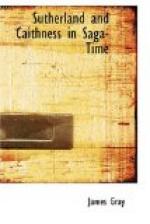To punish Earl Harold, King William at once had Harold’s son Thorfinn blinded and so mutilated in Roxburgh Castle that he died there. William also collected a large army and marched in person to Eysteinsdal or Ousedale near the Ord of Caithness, and Harold, though he is said to have brought together seven thousand two hundred men, avoided battle and evaded the king’s pursuit.[47] Harold also began negotiations with King John of England and received a safe conduct for a journey to England to see him.[48]
Later in the year Harold is said to have recovered his earldom through the intercession of Bishop Roger of St. Andrews, for a payment of two thousand pounds of silver, which Munch conjectures may have been handed over to Ragnvald Gudrodson to replace the sum which he had paid to the king for the earldom; and it is true that we hear no more of Ragnvald in connection with Caithness, though he lived until 1229. At the same time, we can hardly believe that Harold, as the Flatey Book says, received back “all Caithness as he had it before that Earl Harald the Young took it from the Skot-king."[49] What happened probably was, that Harold Maddadson, who had been stripped by King Sverri of Shetland in 1195,[60] was allowed by King William in 1202 to keep part of his Caithness earldom upon payment by its inhabitants of a fine of every fourth penny they possessed. Otherwise his son David could not have succeeded to any part of Caithness, as he undoubtedly did, when, four years later, in 1206, his father’s long and chequered career of sixty-eight years in the earldom was closed by his death at the age of seventy-three.
Ugly of countenance, but of great bodily strength and stature, crafty, self-seeking, treacherous and wholly unscrupulous, he is still known in the North as “the wicked Earl Harold,” yet the Saga classes him with Sigurd Eysteinsson and Thorfinn Sigurdson as one of the three greatest of the Jarls and Earls of Orkney and Caithness.
On the mainland, no new earldom north of the Oykel was conferred on anyone for a further period of thirty years. It was, in fact, neither the policy nor, save in very exceptional cases, the practice of the Scottish kings to grant earldoms to men with powerful followings and vast territories;[51] for these made them, especially in remote situations, almost independent rulers, and dangerous enemies, and it was undesirable to increase their importance by additional dignities. It was, on the contrary, usual by charter to create barons and other military tenants, who should hold their lands, described in their charters, by military service, in male succession direct from the Scottish Crown, and liable to forfeiture for disloyal conduct. Nowhere were military tenants so essential as they then were in the extreme north of Scotland on lands immediately adjoining the territories of Norse jarls owing double allegiance, and therefore of doubtful loyalty to the Scottish Crown. For this reason also no part of the lands of the Erlend line would be granted to the line of Paul, as an addition to their own.




